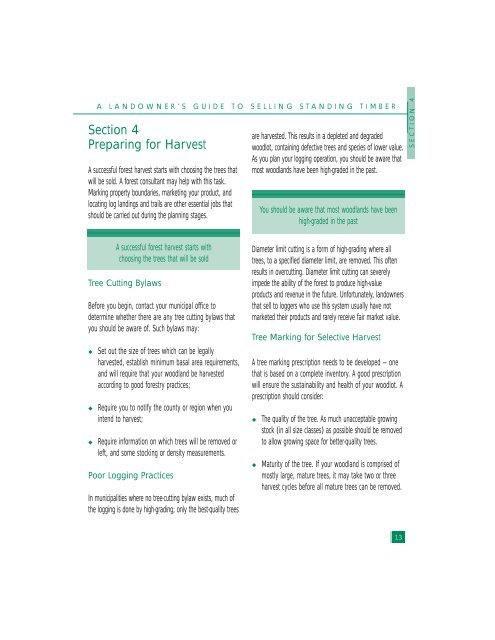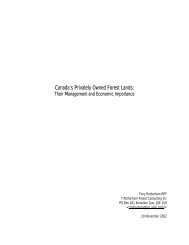A Landowner's Guide to Selling Standing Timber - the Ontario ...
A Landowner's Guide to Selling Standing Timber - the Ontario ...
A Landowner's Guide to Selling Standing Timber - the Ontario ...
Create successful ePaper yourself
Turn your PDF publications into a flip-book with our unique Google optimized e-Paper software.
A LANDOWNER’S GUIDE TO SELLING STANDING TIMBERSection 4Preparing for HarvestA successful forest harvest starts with choosing <strong>the</strong> trees thatwill be sold. A forest consultant may help with this task.Marking property boundaries, marketing your product, andlocating log landings and trails are o<strong>the</strong>r essential jobs thatshould be carried out during <strong>the</strong> planning stages.are harvested. This results in a depleted and degradedwoodlot, containing defective trees and species of lower value.As you plan your logging operation, you should be aware thatmost woodlands have been high-graded in <strong>the</strong> past.You should be aware that most woodlands have beenhigh-graded in <strong>the</strong> pastSECTION 4Tree Cutting BylawsBefore you begin, contact your municipal office <strong>to</strong>determine whe<strong>the</strong>r <strong>the</strong>re are any tree cutting bylaws thatyou should be aware of. Such bylaws may:sssA successful forest harvest starts withchoosing <strong>the</strong> trees that will be soldSet out <strong>the</strong> size of trees which can be legallyharvested, establish minimum basal area requirements,and will require that your woodland be harvestedaccording <strong>to</strong> good forestry practices;Require you <strong>to</strong> notify <strong>the</strong> county or region when youintend <strong>to</strong> harvest;Require information on which trees will be removed orleft, and some s<strong>to</strong>cking or density measurements.Poor Logging PracticesIn municipalities where no tree-cutting bylaw exists, much of<strong>the</strong> logging is done by high-grading; only <strong>the</strong> best-quality treesDiameter limit cutting is a form of high-grading where alltrees, <strong>to</strong> a specified diameter limit, are removed. This oftenresults in overcutting. Diameter limit cutting can severelyimpede <strong>the</strong> ability of <strong>the</strong> forest <strong>to</strong> produce high-valueproducts and revenue in <strong>the</strong> future. Unfortunately, landownersthat sell <strong>to</strong> loggers who use this system usually have notmarketed <strong>the</strong>ir products and rarely receive fair market value.Tree Marking for Selective HarvestA tree marking prescription needs <strong>to</strong> be developed – onethat is based on a complete inven<strong>to</strong>ry. A good prescriptionwill ensure <strong>the</strong> sustainability and health of your woodlot. Aprescription should consider:ssThe quality of <strong>the</strong> tree. As much unacceptable growings<strong>to</strong>ck (in all size classes) as possible should be removed<strong>to</strong> allow growing space for better-quality trees.Maturity of <strong>the</strong> tree. If your woodland is comprised ofmostly large, mature trees, it may take two or threeharvest cycles before all mature trees can be removed.13
















